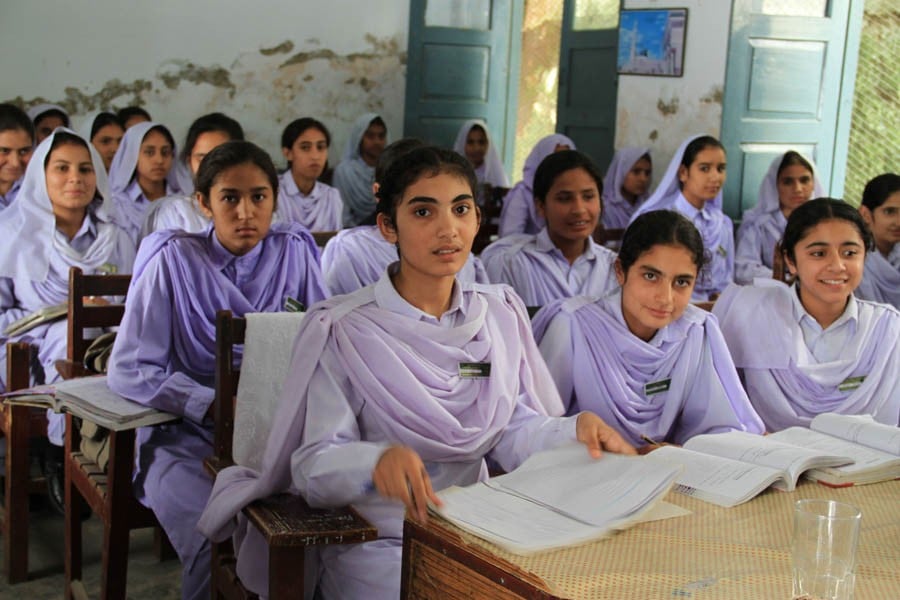
The government will have to invest more in women education to break the cycle of poverty

Pakistan has one of the lowest literacy rate in the comity of nations. About 22.6 million children, most of them girls, are still out of school. The present government had promised to raise the education budget to 4.0 per cent of the Gross Domestic Product (GDP), but only 2.6 per cent budget is being given for education.
The low spending on education is one of the main reasons of Pakistan’s abysmal ranking on the world literacy map. It ranks 144 among 160 countries of the world with a literacy rate of 57.9. There are 22.6 million boys and girls out of school -- that’s nearly half (44 per cent) of all children in the country and out of these more than half, 13 million (or 53 per cent) are girls.
According to Alif Ailaan, an organisation campaigning for promotion of education in Pakistan, there are 50.8 million children in the country between the ages of 5 and 16 of which 24.0 million are out of school. Some 23 per cent of these children drop out in early years and there are 77 per cent children who never went to school. The net enrollment rate at primary school is as low as 57 per cent. This number drops to 22 per cent in middle school and 14 per cent in high school.
The situation is grim particularly for girls and if the current trend or downside continues, we will have more and more uneducated mothers in future and women who are slightly more than men in Pakistan would not be able to contribute to national development and our dream to become an Asian Tiger would never be realised.
Education for girls in rural areas and conservative regions is even a bigger challenge. Moreover, there is lack of schools and teachers in rural areas, while parents do not want to send their daughters outside their homes due to social and conservative background.
Many parents in rural and urban areas argue that they cannot afford to send their children to school because of poverty and they put them on work in early age so that they can bring some money home for food. Thus, the cycle of poverty continues. Education of all boys and girls is must to break this poverty cycle as literacy skills and education help improve lives in so many ways.
A household survey revealed that the topmost reason for low literacy rate among girls is parents’ unwillingness to send their daughters to school. Factors contributing to this unwillingness include lack of basic facilities in schools, poor quality of education, teacher absenteeism and corporal punishment in some cases.
In Khyber Pakhtunkhwa (KP), militant groups have bombed hundreds of schools and given threats that women should not be allowed to study. In our society, coeducation is not allowed for girls due to several reasons. Parents do not send their girls in coeducation institutions as they consider it against social and religious norms. The government has also not been able to provide separate schools and classrooms for girls. That is why girls remain deprived of education which results into poverty, child labour and early marriages.
According to UNICEF, about 31 million of primary students and 32 million of girls of lower secondary school were out of school in 2013. Girl’s education is essential to the achievement of quality learning relevant to the 21st century including girl’s transition to and performance in secondary school. In northwestern tribal areas, education of females is strictly banned on religious basis .
Pakistan is a country in which 52 per cent of the total population comprises women as per the 1998 census. So keeping our majority of the population uneducated is alarming situation and this might be the root-cause of unstable economy of the country.
Education of female can have a positive impact on health of our population. According to Alif Ailaan only 40 per cent uneducated mothers immunise their children against deadly and crippling diseases, while the immunistion ratio is 74 per cent among educated mothers.
Just 60 per cent of uneducated women seek prenatal care, compared to 91 per cent of those who are educated. 39 per cent of children born to mothers with no education are underweight. For mothers with secondary or higher education, this figure drops down to 10 per cent.
The neonatal mortality rate among mothers with no education is 65 per 1,000 live births, compared to 27 per 1,000 live births among those who have completed higher than secondary education. Women having completed at least 11 years of education are one and a half times more likely to seek prenatal care from a skilled health provider as compared to women with no education.
We can also tackle the problem of rapidly growing population through education as a survey has found out that fertility rate were higher among uneducated mothers when compared to educated ones. The fertility rate (number of children per woman) among women with no education is 4.4, compared to 2.5 among those who have some education.
The government should make education of all children its priority and allocate 4.00 per cent of the GDP for education. It should create state of the art teachers training facilities. Besides improving existing schools, it should build more schools across Pakistan, particularly in the rural areas.
As an incentive for parents who cannot send their children to school, the government should start school meals programmes and give stipends to every child enrolled so that these kids do not end up on streets doing child labour. Teaching service should be reorganised and teachers’ salary should be attractive with additional fringe benefits.
Education is not only the right of every Pakistani, but it is a religious obligation for Muslims to obtain education. If Pakistan has to break the cycle of poverty, it has to invest in education of its children.